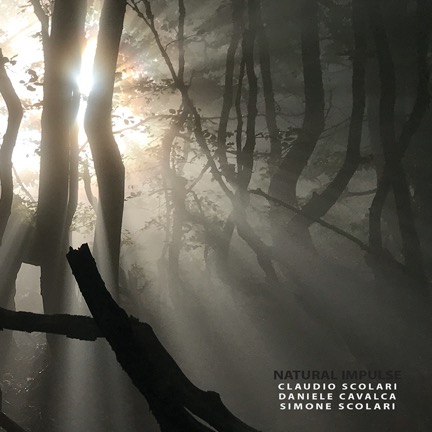
@LONDONJAZZNEWS
NATURAL IMPULSE
Claudio Scolari | Principal Records (2018)
ON 27 MAY 2018 BY AJ Dehany
Natural Impulse (Principal Records), the third album by Italian trio Claudio Scolari, Daniele Cavalca and Simone Scolari, was released in January. AJ Dehany and Claudio Scolari took a moonlit walk through the album in Italian and English via email, discussing the group’s inspirations in musical storytelling.
LondonJazz Newa: Many of the titles – Unknown Destination, Chasing Inspiration, Uptown Night Trip – suggest a love of the journey for its own sake. Where are you journeying?
Claudio Scolari: Natural Impulse is something deep that comes from our soul which we try to communicate with music. It includes some deep ancestral sensations and emotions. Navigating without a clear destination allows us to be ourselves and yet also to reveal the stories and personal sensations of the different cultures that surround us.
1. Unknown Destination
LJN: The opening track has an exciting electro-acoustic arrangement. How do you layer the sound in the studio? Is the destination really unknown?
CS: Melody is very important in our music, always surrounded by the electronic parts that let us create space and warm sounds around the melodic material. It’s a complex mixture of influences, and it’s hard to find your own sound even though I believe, as an artist, you have to chase it.
2. American Skyscrapers
LJN: The vibraphone is a very resonating instrument but the production is quite reined in; the track is also reminiscent of a gospel-influenced style of American jazz?
CS: The vibraphone is not approached as the typical solo instrument like big names such as Mike Mainieri and Gary Burton do it. It is more connected to contemporary classical music. I originally thought about it as a Blues but Daniele and Simone found a more interesting, jazzy idea, so we went for that. It has a strong energy and the melody excites me a lot.
3. Chasing Inspiration
LJN: This seems to obey a live trio format rather than using overdubbing. How does it compare between live and studio? What inspiration are you chasing?
CS: The studio functions as a sort of laboratory where tend to experiment a lot, while in a live situation it is challenging to arrange the song simpler. Our inspiration doesn’t have a specific source. We always have in mind what the great artists have done in the past. Coltrane, Monk, Parker, Miles and today’s artists DeJohnette, Hancock, Frisell and Jarrett have created a universe of music.
4. Natural Impulse
LJN: A memorable Monk-like piano theme. Why did you opt to leave out the trumpet?
CS: We wanted to keep the song very simple just with piano and drums with just me and Daniele. Not every song follows the same instrumentation. Natural Impulse is for us an example of what we think about Thelonious Monk. He was not just a great pianist, he was Monk!
5. Moon Mood
LJN: There’s a mixture of “out there” electronic sounds with the trumpet improvisations. Is the moon another unknown destination toward inspiration?
CS: Our music has an inspiration that seems undefined after a first listening but has general influences that somebody compared to ‘world music’, which today is a mixture of many sonorities and different styles. We must always be open to new things.
6. Dear John
LJN: It feels emotionally engaged, with a very full almost Vangelis-like sound. Who is John and what are you saying to him?
CS: Dear John is a delicate moment dedicated to one of my favorite musicians, John Abercrombie: a truly versatile musician but closely linked to jazz tradition. His improvisations are very instinctive and never lack that creativity worthy of great jazz musicians.
7. Uptown Night Trip, 8. Insomnia and 9. Over The Horizon
LJN: An almost-suite like sequence with to a more exploratory feel with rich electronic textures and a memorable trumpet themes, reminiscent of In a silent way. What keeps you awake at night?
CS: There are many inspirations when you travel the night and cannot sleep, visiting strange dimensions almost separate from you and your deep self. The images become sounds and rhythms that appear quiet but at the same time restless. What keeps us awake is the thought that the world can not find the feelings and the honesty that music and art in general have in its form of respect in man and in the universe.
10. South Hemisphere
LJN: How do you view the Southern Hemisphere? Africa has a huge importance for jazz…
CS: South Hemisphere was born as a single moment, a light. The cover of the single represented a pregnant woman with the colors and the depths of creation: the will of harmony and the perfection inherent in matter. Yes, Africa has a major importance in jazz, but we were trying to think of something as far as possible. The birth of an individual is really far out.
LJN: What are your inspirations and ambitions for the trio?
CN: We all three studied classical music, then searched for our own style in the jazz world. Being in and out of the rhythm structure is a characteristic of our music, and we have tried to search for a language that blends harmony, rhythm and dissonances. The inspirations are constantly evolving. The world is full of musicians who have something to say. Music is beautiful for that reason, it’s in constant evolution. There will always be purists who never want to change their music, and also those who are open to the world.
AJ Dehany is based in London and writes independently about music, art and stuff.